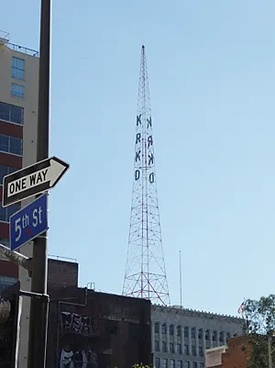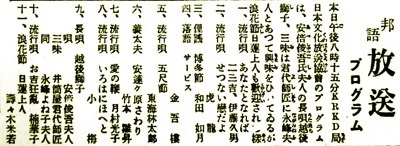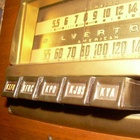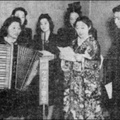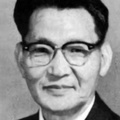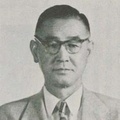The antenna tower with the neon sign of KRKD, which stands on the roof of an arcade building near Broadway and 5th Avenue in Los Angeles, has been a beloved downtown landmark for many years. Before the war, KRKD had a studio on the third floor of this building, where Japanese people gathered every Monday night to broadcast a 30-minute Japanese program. Thus, KRKD was a familiar broadcasting station to Japanese people living abroad.
Japanese language broadcasts began on KRKD in September 1932. Initially called the "Japanese Radio Broadcasting Association," the program was hosted by Sugimachi Yaemitsu, a reporter for the Rafu Shimpo, and Louise Susuki, editor of the paper's English language column. Although it was not run as part of the newspaper's business, it appears that the paper initially backed the program, using the Rafu Shimpo's address as contact information and publishing the program listings exclusively.
On the first day's program, Kito Fumiko, who had just graduated from Rafu Daiichi Gakuen, was in charge of the announcements, and the program featured congratulatory speeches from Rafu Japan Association Chairman Mukaida, Central Japan Association Chairman Abe, Consul Sato, and a solo performance by Inoue Kyoko and a violin performance by Jimmy Yamamoto. With influential members of the local Japanese community on the program, it felt different from a mere commercial program. In the early days, the program actively featured young second-generation musicians and Japanese language school students, but over time it began to include more entertainment elements, using Japanese records.
On October 6th, a month after the broadcasts had started, a meeting was held at the Chinese restaurant Sankorou in Little Tokyo to discuss the future of Japanese language broadcasting. As a result, it was decided to incorporate in order to solidify the organization and to change the name to Japan Cultural Broadcasting Association.
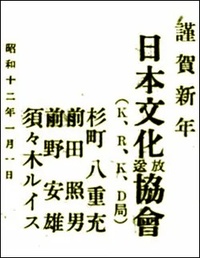
The Imperial Consul, the chairman of the Japanese Association, the president of the Hoji Shimbun, the head of the Japanese Language Academy, and a prominent shop owner were nominated as advisors to the Broadcasting Corporation. The actual program management was handled by Sugimachi, Susuki, Maeda Teruo (a reporter for the Rafu Shimpo), Kurihara Yoshiyuki (a teacher at Rafu Daiichi Gakuen), Tashiro Aiko (a pianist), Kito Fumiko, Oza Hondo, Murata Goro (a reporter for the California Mainichi Shimbun), Miyake Tomoyuki (Ikeda Trading Company), and Maeno Yasuo (a lawyer). A full-scale operational structure was established that was significantly different from previous Japanese programs.
In 1934, a time slot was created for Japanese-language newspapers, with the Rafu Shimpo, the California Mainichi Shimbun, and the Shin Nichibei Shimbun taking turns broadcasting the news. Religious programs such as a program commemorating the founding of Higashi Honganji Betsuin, a broadcast of the Buddha's Birth Flower Festival, and a special program for the Obon memorial service at Nishi Honganji Betsuin were also broadcast. In regards to Christianity, a new program called Sunday Cultural Broadcasting began on KGER in Long Beach in November 1937, featuring sermons by the Rev. Watanabe Sozaburo of the United Church and performances of various records.
The industry magazine Broadcasting featured the show in September 1934. It noted that at the beginning and end of the show, the show called on people in English to visit the Little Tokyo area, and that 500 radios were sold in Little Tokyo within 45 days of the show's start.
A diverse range of people gathered on the show and went on to become its director. Charles Yoshii, who was in charge of the English language announcements in the early days, became the chief English language announcer when Japan Broadcasting Corporation began broadcasting overseas in 1935. Murata Goro, a reporter for the California Mainichi Shimbun who appeared in the story-based radio drama, served as editor-in-chief and director of The Japan Times.
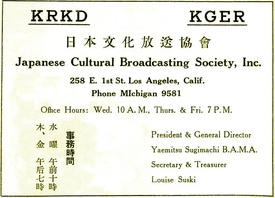
Eiji Tanabe, a reporter for the California Mainichi Shimbun who was responsible for many radio dramas and lectures, served as president of the Rafu Japanese Citizens Association and president of the Southern California Japanese Chamber of Commerce. Steve Kamayatsu (father of Hiroshi Kamayatsu) made his radio debut on a program on October 24, 1932, performing a solo rendition of "St. Louis Blues" on ukulele and banjo, and later became a successful jazz musician in Japan. Yukito Itano, a baritone singer who gained popularity as a singer of Masao Koga's "Nisei Koushinkyoku," became a Japanese announcer for the Japan Broadcasting Corporation.
Although the program became an indispensable part of Japanese society, it received numerous letters of protest from the American community. Sugimachi responded to these complaints courteously, and the Japanese language program continued to be broadcast until just before the outbreak of war between Japan and the United States.
*This article is an excerpt from Japan Hour (2020) and reprinted from The Rafu Shimpo (April 24, 2021).
© 2022 Tetuya Hirahara


